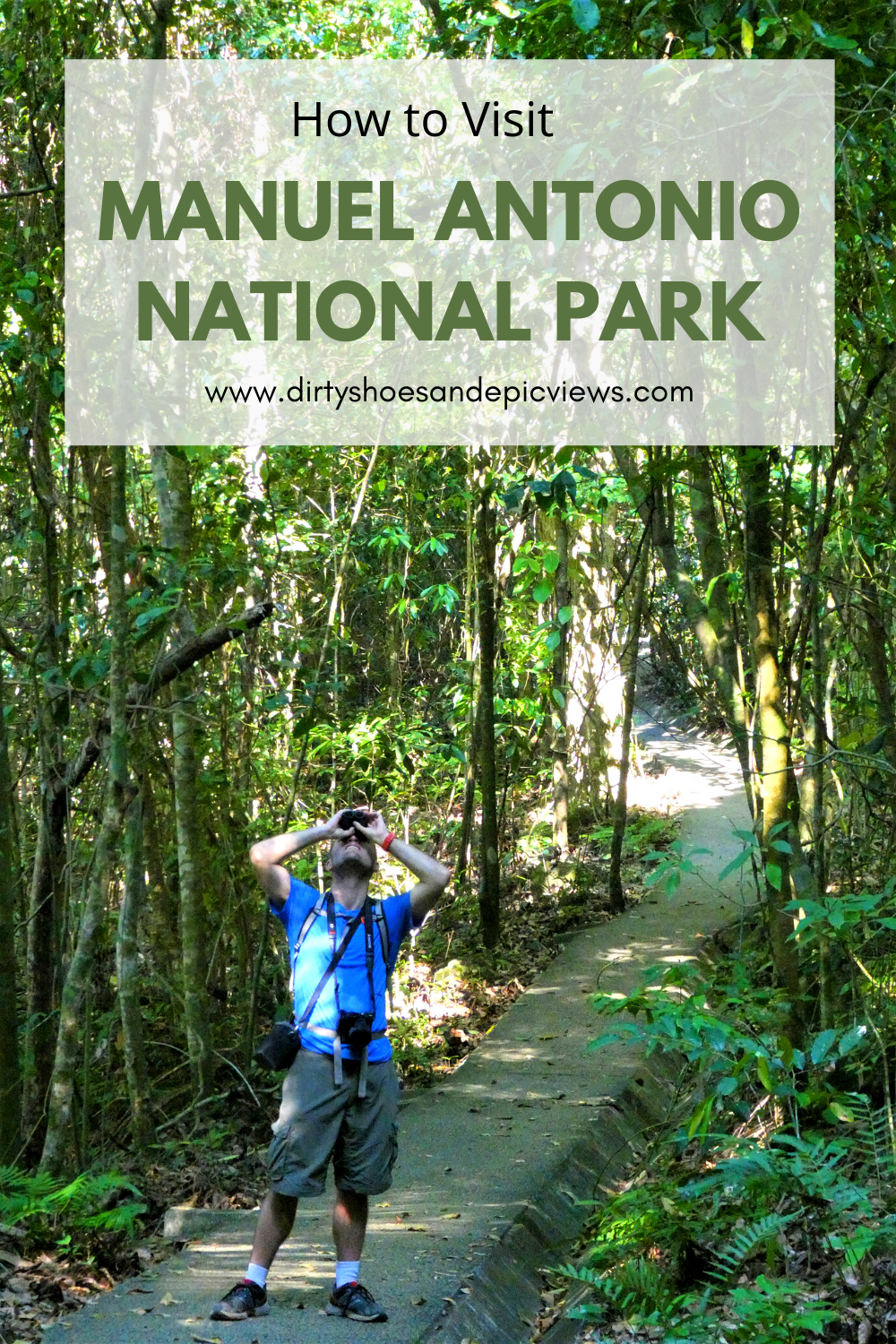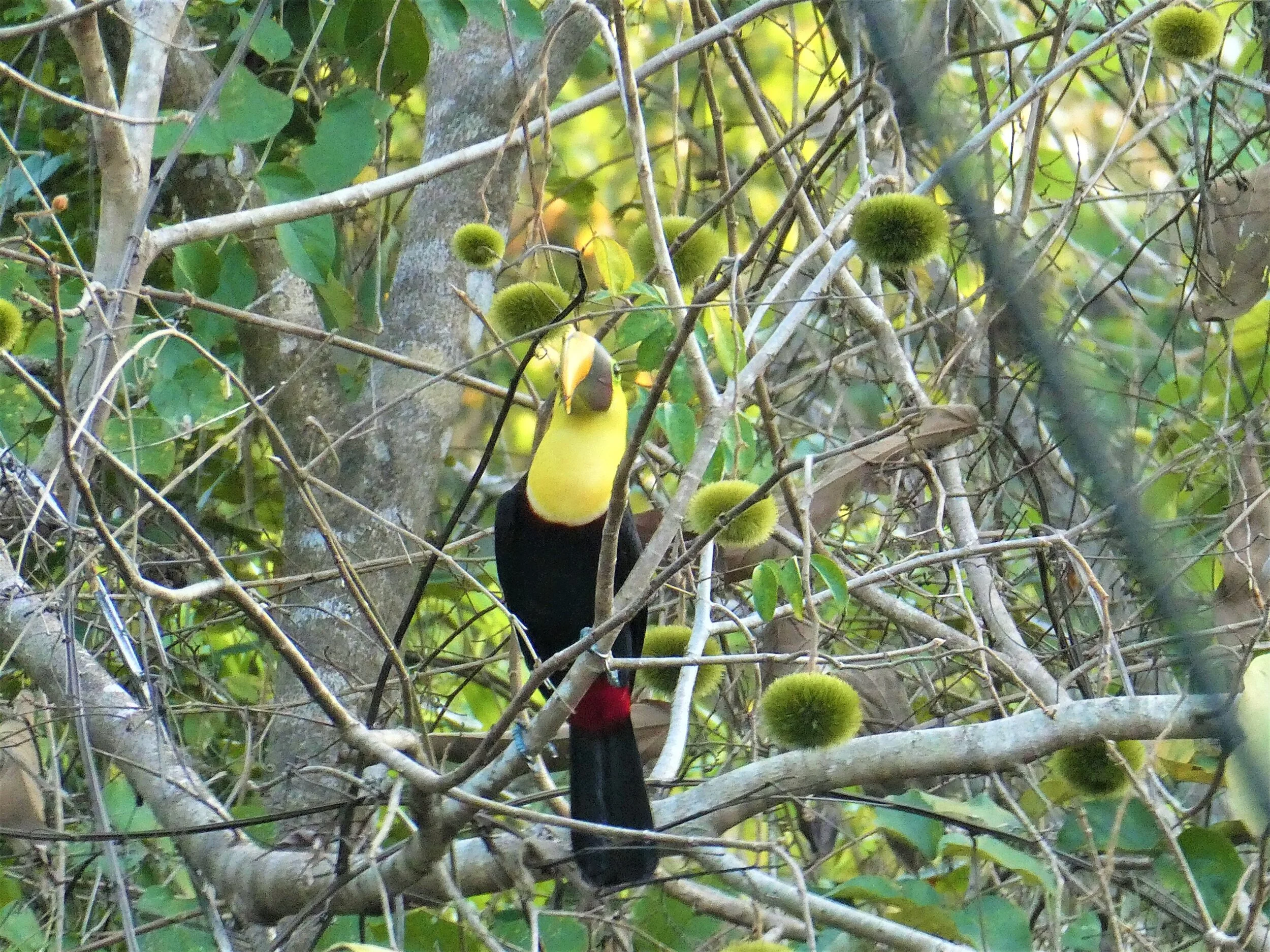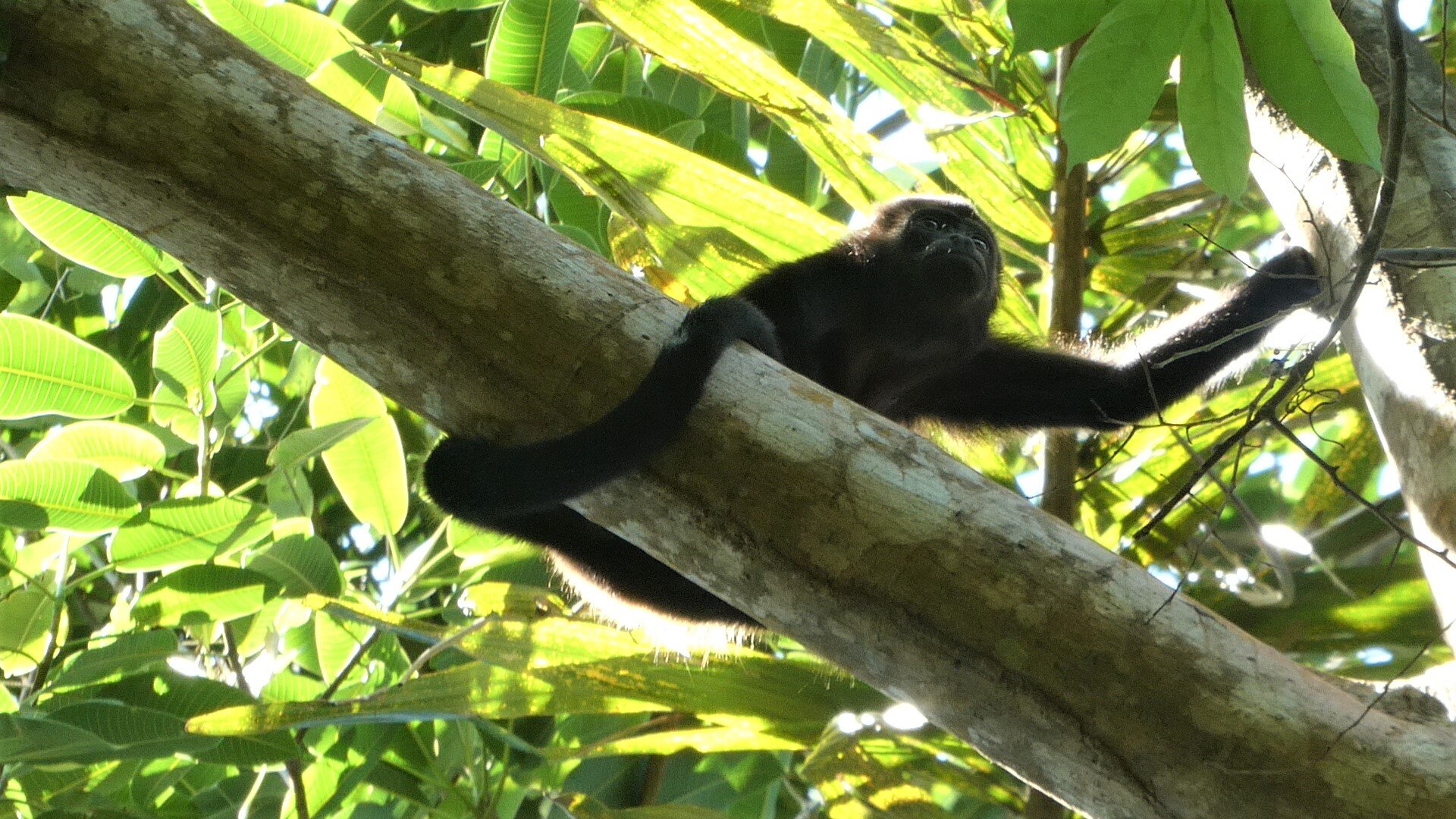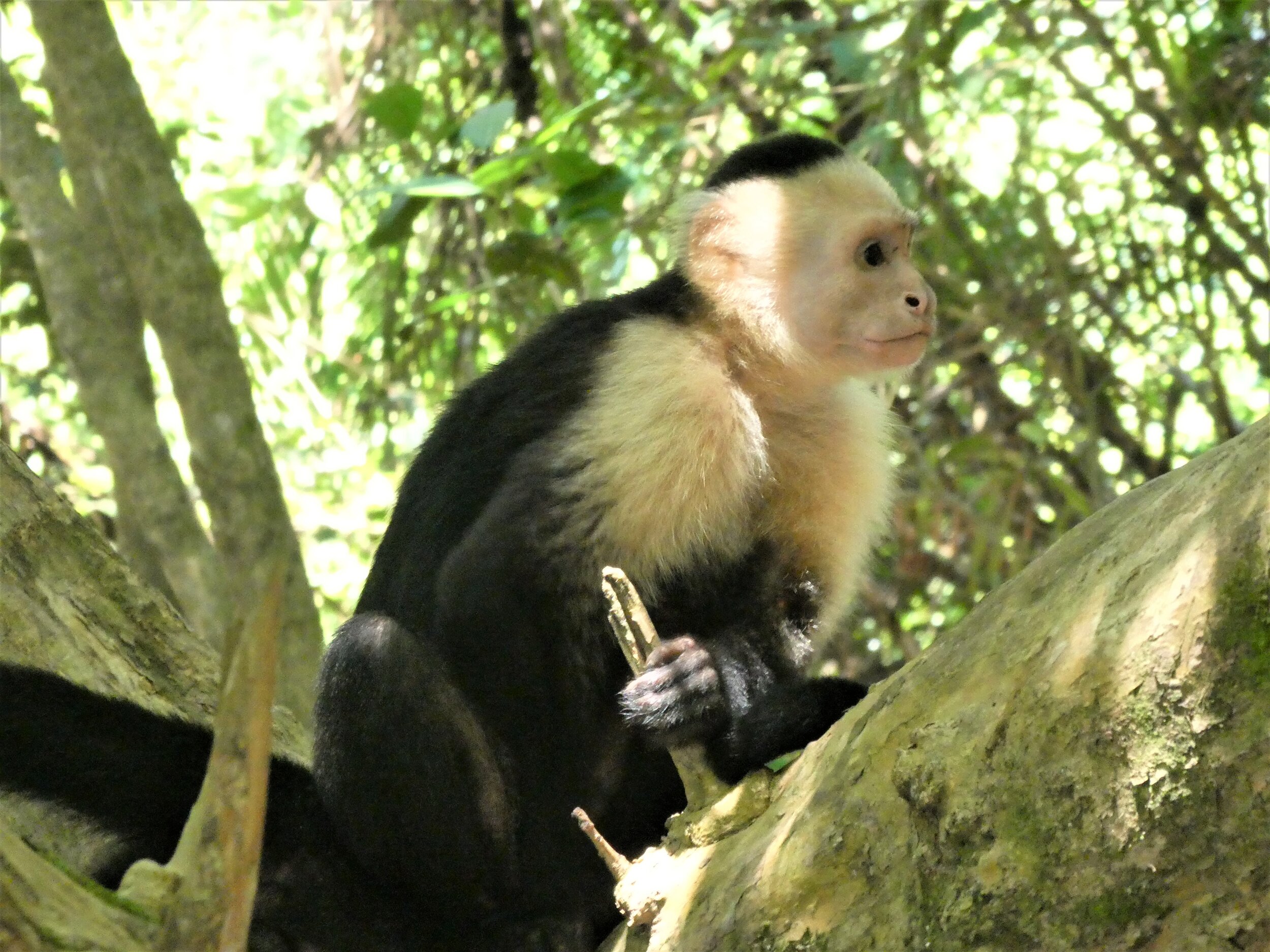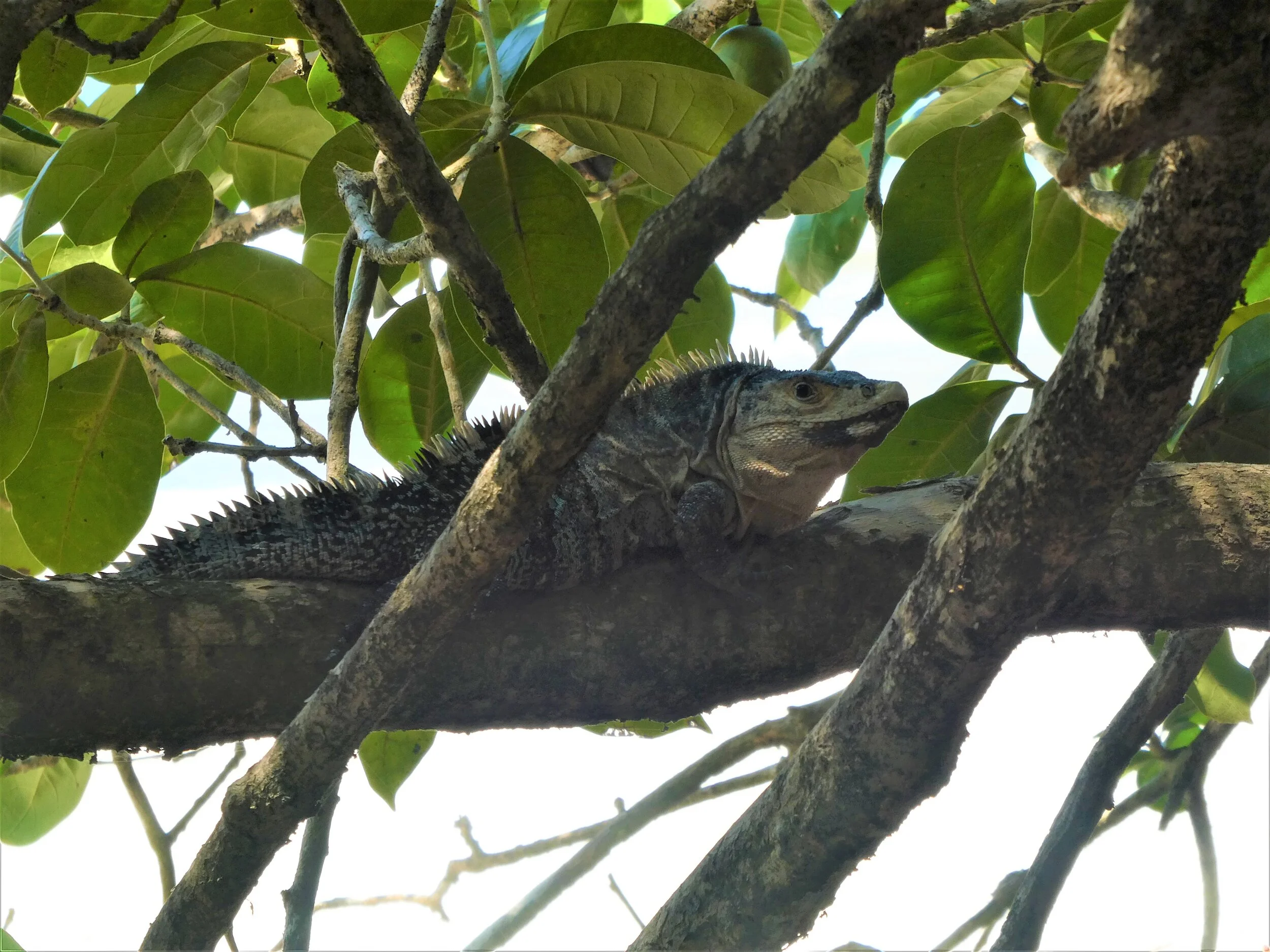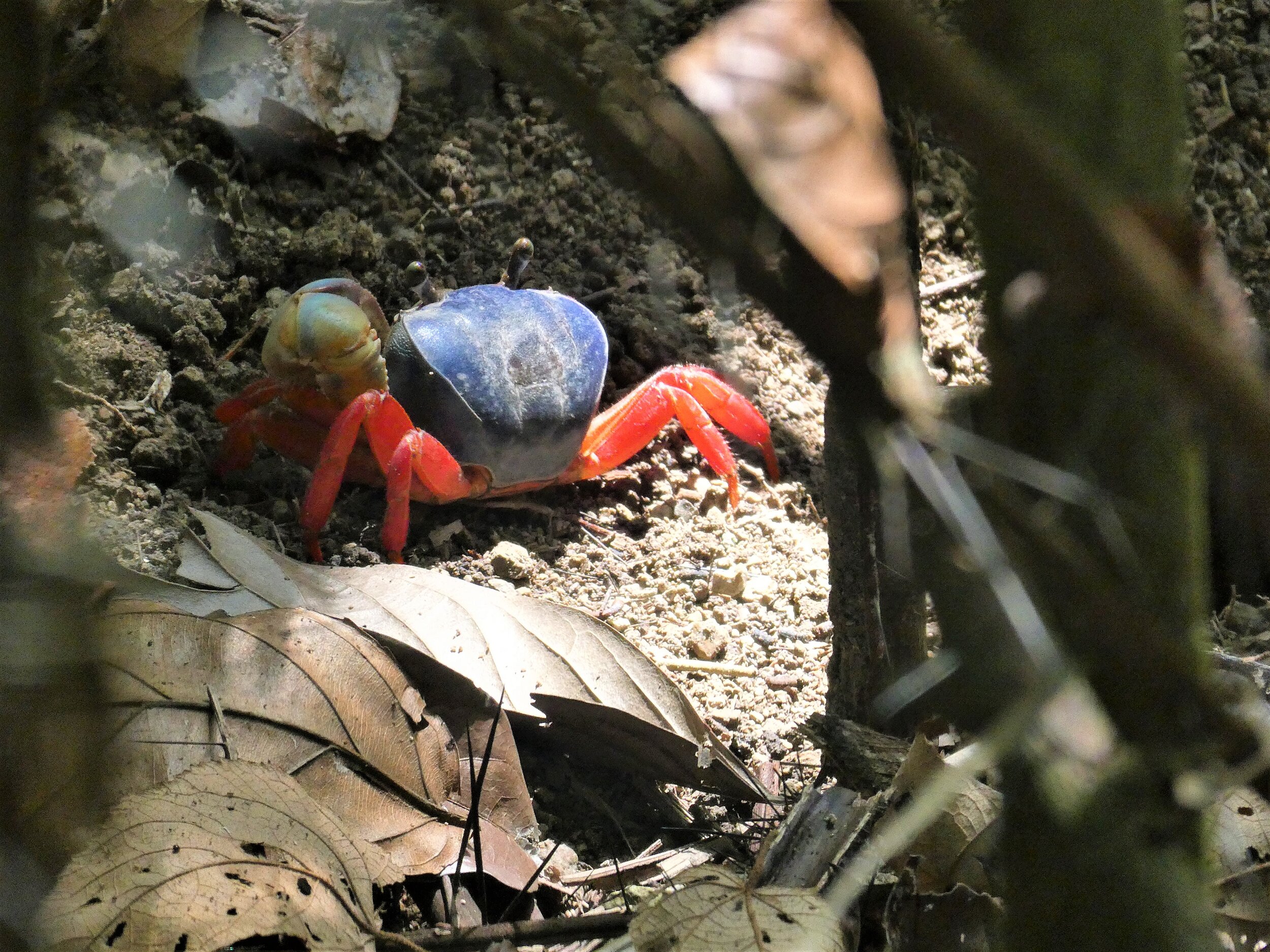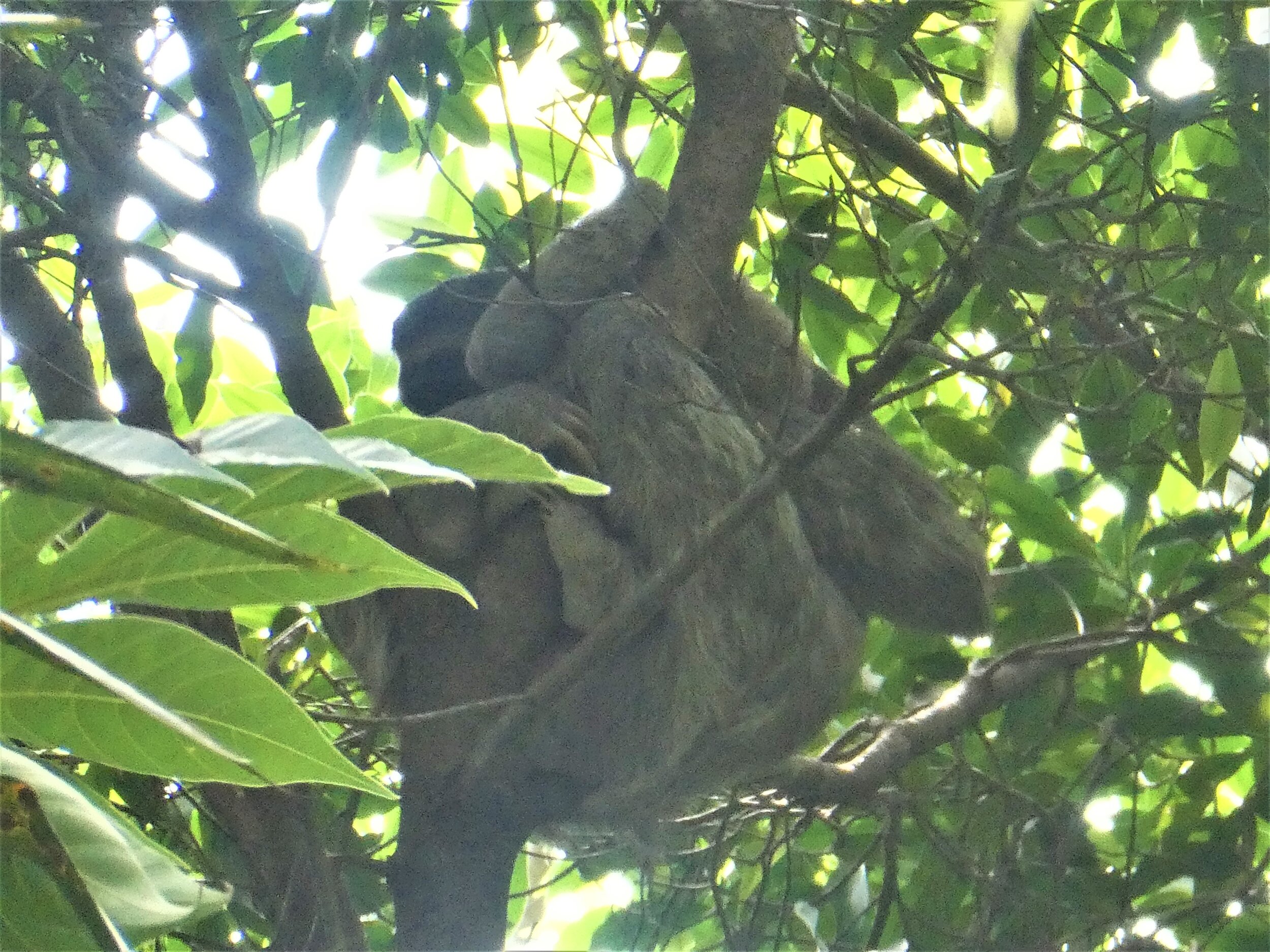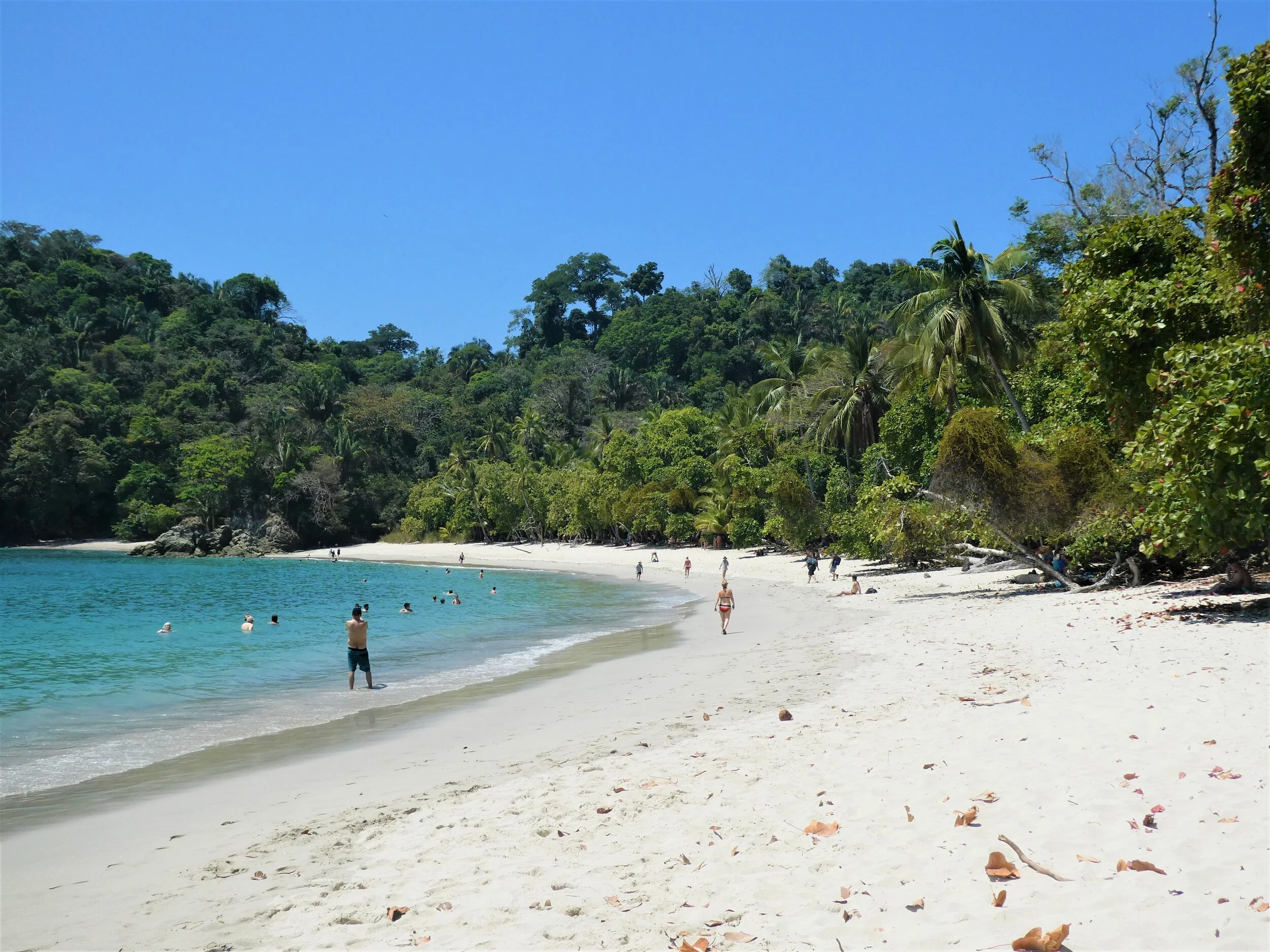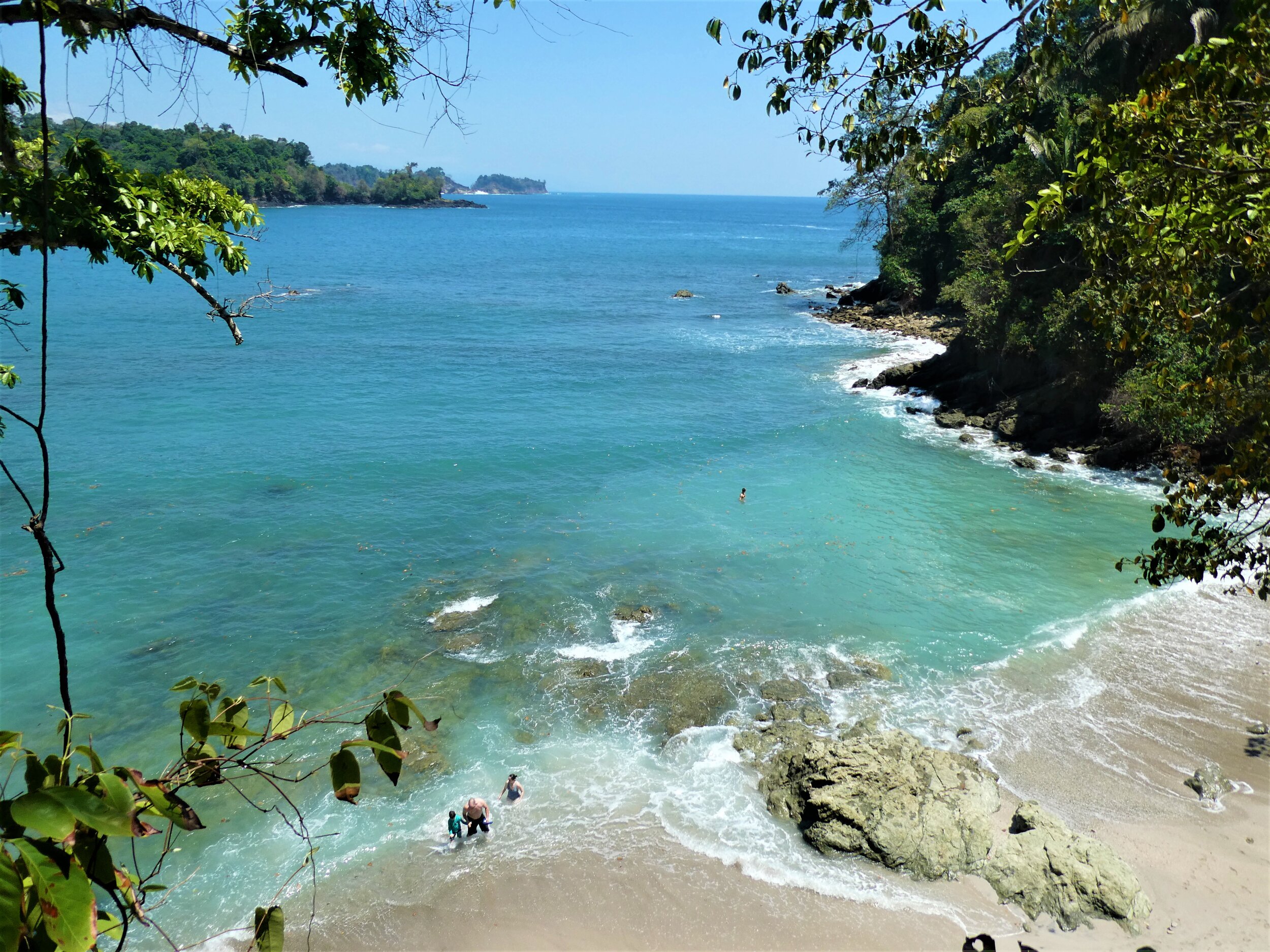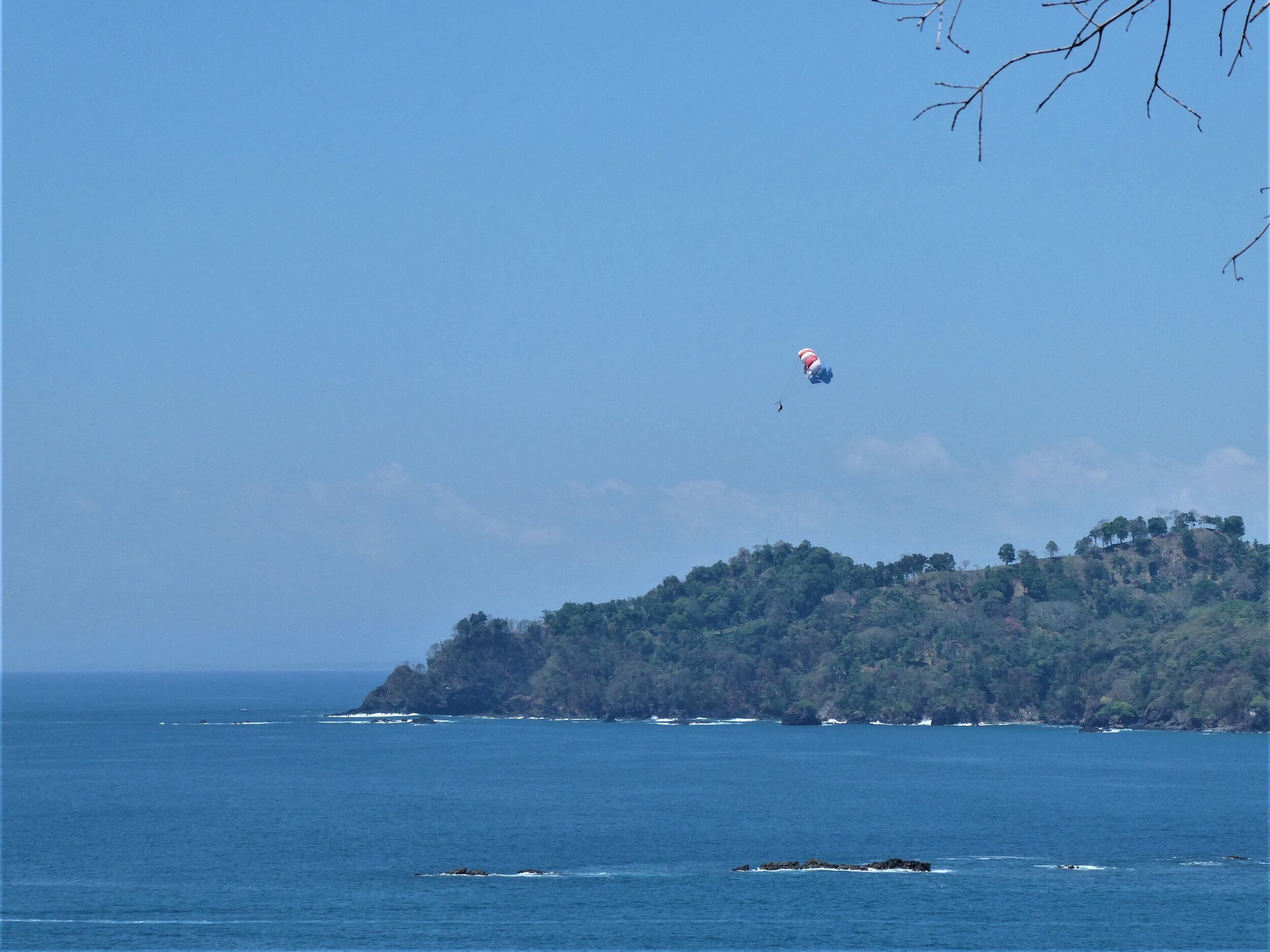How to Visit Manuel Antonio National Park in Costa Rica
If you’re looking for wildlife in Costa Rica, then a visit to Manuel Antonio National Park should be on your must-do list!
Found along the Central Pacific Coast of Central America, Manuel Antonio protects just over 1900 hectares of land, making it the smallest National Park in the country…but don’t let that fool you! This is one of the most popular parks in all of Costa Rica, and for good reason. It’s teeming with diverse wildlife, from curious monkeys to lazy sloths to scurrying land crabs to colorful tropical birds and everything in between. Couple this with miles of trails through pristine rainforest, picturesque white sand beaches, and beautiful views, and you’ve got yourself one of the best places to visit in Costa Rica.
In this guide, we’ll go over everything you need to know to on how to plan your visit to Manuel Antonio National Park, including how to get there, how to buy tickets, what trails to hike, how to spot wildlife, how to avoid the crowds, and much more!
Article Contents
Want to save this article for later? Pin it and come back any time!
How to Get to Manuel Antonio National Park
Manuel Antonio National Park is pretty easy to get to. If you’re renting a car, you can drive there yourself. Since it’s such a popular park, you can also opt for public transportation to get you there. Let’s go over both!
Driving to Manuel Antonio
Driving to Manuel Antonio National Park is pretty straightforward and does not require a 4x4, as all roads to get here are paved.
A typical home base for visiting the National Park is either in Quepos or the town of Manuel Antonio.
From San Jose, Quepos is about a 2 hour and 45 minute drive (easily done via Google Maps). You’ll pass through four tolls, the most expensive of which was 760 colones.
From Quepos, Manuel Antonio National Park is just 15 minutes away. You will take route 618 out of Quepos, following it up and over “the hill” that sits on the coast and separates Quepos from the park. You’ll drive through the town of Manual Antonio at the top and then descend back down the other side to the beaches and the park.
When you get to the bottom of the hill, you’ll pass the public beach on your right. Keep going until you see Marlin Restaurant on your left. Turn left here, and the park entrance will be at the end of this road.
Parking at Manuel Antonio National Park
We read multiple times before coming here that the road on the way to the park will be filled with people potentially dressed as park staff, rangers, or tour guides trying to sell people their services, including overpriced parking far from the park.
What to do? Just keep driving on by…
For parking, you should go all the way to the park entrance, and there will be parking just before it with attendants directing you where to go. We paid 4,000 colones for the whole day, but it may be cheaper if you go in the off (wet) season.
Be sure not to leave anything valuable visible in the car. There are parking attendants, but there are only a couple, and LOTS of cars.
Public transportation to Manuel Antonio National Park
If you aren’t renting a car in Costa Rica, there are definitely ways to get to Manuel Antonio National Park using public transportation.
From San Jose
Local flight: Daily flights between San Jose and the Quepos airport run 5 times a day on Sansa, Aerobell and Skyway airlines. It costs between $75-95 USD, but you’ll still need to find transportation from Quepos to the park.
Public bus (“colectivo”): This is by far the cheapest option from San Jose, but will take about 4 hours. Buses leave from SJO airport several times a day going to Manuel Antonio. You can ask to be dropped off at Marlin Restaurant and from there it’s a short walk to the entrance. The public bus is $8.
From Quepos/Manuel Antonio
Taxi: Costs between $5-10 USD depending on where you are staying.
Public bus: Runs between Quepos and Manuel Antonio National Park every 20 minutes. The ride is just 0.60 cents each way! You’ll get dropped off at Marlin Restaurant and walk the rest of the way to the park entrance.
Semi-private and private transportation: This is the most expensive option, costing up to $60 per person for a semi-private transfer and up to $300 total depending on the group size and where you’re staying. You can contact the National Park itself to arrange this.
Entrance Fees and Hours For Visiting Manuel Antonio National Park
Manuel Antonio National Park is open from 7am to 4pm every day EXCEPT Mondays, when it is completely closed.
You need a park pass to visit Manuel Antonio, which costs $16 USD per person (free for kids 12 and under). They are only good for one entry, so you can’t leave the park and come back without repaying the entrance fee.
How to buy tickets for Manuel Antonio National Park
Tickets to Manuel Antonio can’t be bought online ahead of time…they have to be purchased (with USD, colones, or card) at a bank called Coopealianza. They can be purchased at two different locations:
One is located just outside of the park entrance (open 7am-3pm every day)
One is located in Quepos (right next to the Pali grocery store down town; open 8am-5pm Monday through Friday or 8am – 12 pm on Satuday).
You can buy them the day of your visit or in the afternoon the day before your visit. We recommend purchasing your tickets the day before. Why? Two reasons:
First, there are limits to the number of visitors a day into Manuel Antonio National Park. They cap it at 800 visitors allowed in the park at any one time on weekends, and 600 at any one time on week days, which sounds like a lot, but that’s just how popular this park is! Purchasing a ticket the day before can help you ensure that you’ll get one of these tickets.
Second, purchasing a ticket the day before will help you avoid long lines the day of your visit. If you buy your ticket the day of, you’ll have to wait in two separate lines- the first is to buy your ticket and the second is to get in. Both lines can be long, and if the park has reached its cap, you’ll be waiting in line to get into the park until people start trickling out and making space for more people. And the longer you’re in line, the less time you’re in the park enjoying it! We had read that in the high (dry) season (December to April), you’ll want to get to the park at 6 am before it even opens just to get in line at the ticket office (and this is separate from the line to actually get in to the park). There have even been people who have had to wait for hours just to get in…yikes!
The line starting to form outside the Coopealianza bank just outside of the Manuel Antonio National Park entrance
Well, of course we didn’t want that to happen to us. I was really looking forward to visiting Manuel Antonio and I wanted a solid day to spend in it. So, we bought our tickets the day before in Quepos.
The next morning, we got up bright and early and got to the park entrance by 6:30am, thinking we were late and were going to end up in a huge line. But, to our surprise…we were the first ones there. There was one family waiting at the Coopealianza Office for tickets, but since we already had ours, we headed for the park gate. It felt kind of funny being the first person in line! As 7 am approached, a few more groups formed in line behind us, along with one tour group, but when the gates opened, there really weren’t at all the number of people I was expecting for an early March day! And as soon as the gate opened, I was the first person in the park (I don’t know why, but this made me feel special).
First in line!
Even though we had no problem at all getting in, I would still recommend getting there early, especially around holidays and school vacation times. I really don’t know what the lines looked like just an hour later to get in and if people had to wait or not, but I would be safe rather than sorry and try to get there as close to opening time as you can.
Plus, the earlier you go, the more time you have to enjoy the park, spot wildlife, and avoid the heavy midday crowds.
What to Pack for Manuel Antonio National Park
Food: Bring snacks, but only certain kinds. The park only allows water and non-alcoholic drinks, wrapped sandwiches, and prepared/cut fruits (nothing wrapped in tin foil). For the safety of the park’s wildlife, snacks like chips and pretzels, canned foods, nuts or seeds are not allowed, and park rangers at the entrance gate will be checking bags before you are allowed in.
There is a small cafeteria in the park near Playa Manuel Antonio, but it’s pretty expensive.
Comfortable hiking shoes: There are a lot of trails to hike around in the park, and the beaches themselves are a bit of a walk. They are all easy trails, so sneakers or hiking sandals such as Chacos would be fine here.
Sunscreen and a hat: The sun is strong on the Pacific Coast, and Manuel Antonio is no different. The trails through the rainforest are, for the most part, shaded, but on the beaches and at various viewpoints you’ll be in the sun, and burns happen fast here! Bring lots of sunscreen and reapply often.
Reusable water bottle: It gets hot and humid here, with temperatures in the 90s. Bring plenty of water. There are potable drinking water stations along Playa Manuel Antonio to refill your bottle.
Bathing suit and towel: There are bathrooms and changing rooms at both Playa Manuel and Playa Espadilla Sur.
Binoculars and a good camera with decent zoom: For spotting wildlife and capturing some good photos!
Best Things to Do in Manuel Antonio National Park
Ok, you’ve got your tickets, packed your bags, and are ready to go! Let’s take a look at all the awesome things to do at Manuel Antonio National Park.
Take a hike!
There’s a good amount of trails in the Manuel Antonio National Park, and they are all relatively easy, making hiking the best thing to do in Manuel Antonio (at least we think so!). Some parts of the main trails that go to the beaches are flat boardwalks and are even wheel chair accessible.
The less commonly traveled trails are still pretty easy, but not flat…they have lots of stairs which are intensified by the heat of Costa Rica’s Pacific Coast. But they lead to nice view points of the park and surrounding jungle and ocean.
The best part about hiking in Manuel Antonio is the opportunity to see all the wildlife! And this place has lots of it, if you’re patient and really vigilant. We recommend taking it slow as you’re walking through the park, so that you have a chance to really look around. During our time at Manuel Antonio, we saw sloths, racoons, deer, tons of crabs, lots of monkey (3 kinds!), agoutis, lizards, and iguanas. We will admit, though, spotting wildlife on your own is quite challenging, so if you really want to see a lot, hiring a guide is probably your best bet (see below).
Plaques with park maps are located throughout the park at each trial intersection, or you could try to get one at the ticket office.
Take a guided tour of Manuel Antonio National Park
Ok, honesty time: If seeing wildlife is your top priority when you visit Manuel Antonio, then you might really want to consider hiring a tour guide for the park. Why? Spotting animals on your own is tough. Take it from us. We naively came with the idea that we would easily spot sloths left and right hanging out on the trees above us, since from what we read, it sounded so easy to do. Well, not the case, as you might imagine. Finding elusive wildlife like a sloth requires patience, a lot of luck, and a trained eye.
Some animals are easy to spot. You’re likely not going to visit Manuel Antonio on your own and not run into a group of mischievous monkeys playing on the beach or in trees above the boardwalk.
But sloths, good luck! (And a sloth has to be on your list of animals to see in Manuel Antonio!) We didn’t find a single sloth on our own here. And believe me, we tried. We walked along the Sloth Trail…I mean, it’s named after these guys, we should be able to find them right?...going painstakingly slow and keeping our heads up so much that we were starting to get strains in our necks. No sloths. The foliage here is just so thick and sloths are so well disguised and pretty much don’t move or make any sounds, so unless you really know where to look and have a trained eye, chances are you won’t spot one.
I mean, look at this jungle. How can you find a sloth in there?
We saw four sloths (and two babies!!) while we were in Manuel Antonio (and f.y.i. none of them were on the Sloth Trail! *womp womp*). We found all of them because of other people (usually in tour groups) were crowded around looking up at something, so we joined in. It’s not the most climatic way to find one, but it’s usually how they’re found.
Guided tours are much more expensive than visiting the park on your own. They cost $51 USD per person for a group tour and about $20 more for a private tour, but these prices include round trip transportation from your hotel in Quepos or Manuel Antonio to the park, the entrance fee, a 2.5 – 3 hour tour, some fruits to snack on and some water, and of course, the guide.
The guides are great resources to have. They know how and where to look for the wildlife. In fact, it seems like they already know ahead of time where the animals will be. A few times we saw guides walking along not even looking around only to suddenly stop, put down his scope in the exact direction needed, and start pointing out the animal to the tour group. This is partly due to the fact that the guides all seem to work together, communicating with each other where they spotted wildlife and directing them there. But mostly this is because animals like sloths don’t tend to move around much, so if they saw a sloth in one spot previously, it’s likely to be there for a while, even months! And it’s easy to keep tabs on them overtime. The guides just know “the spots”. Other times, we saw them definitely working to find things, especially birds. One guide apparently spotted a rare Resplendent Quetzal on the beach that kept hopping through the trees, and he was running all over the place trying to spot if for his group, but alas, it flew away unsighted.
Once they do spot something, they have giant scopes for you to look through for a better view of a far away animals (and most of them will be far away), and they even help you take pictures with your phone through the scope. They’re also a great resource for learning more about the animals you find and the environment you’re walking through. They are professional naturalists, after all.
So, while a bit pricey, it may be worth it. Here are some pros and cons to taking a guided tour at Manuel Antonio:
Pros for a guided tour in Manuel Antonio
You’ll have a way better chance of seeing a diversity of wildlife, including those hard to spot animals like sloths (and who doesn’t want to see a sloth…).
You get transportation included, which is helpful if you haven’t rented your own car and don’t want to figure out public transportation.
You’ll get an educational experience with a professional guide.
Cons for a guided tour in Manuel Antonio
It’s expensive, costing over three times more than doing it on your own.
Your time is limited at the park. You’’’ have roughly three hours with your guide, which does include some time at the beach. But, if you want to spend more time hanging out and relaxing, or hiking around the less travelled trails in the park that a tour wouldn’t take you on, then you’re on your own and have to provide your own transportation back to your hotel.
Also, don’t get me wrong, if you choose not to hire a guide during your visit to Manuel Antonio, you will most definitely still see wildlife. We visited Manuel Antonio on our own to stick to a budget and still saw plenty and we very happy with what we did see. And when you to manage to find something on your own, it’s exciting! The one time I spotted a quiet unassuming howler monkey high up on a tree branch all on my own made me feel accomplished… It’s just your chances, luck, and experience might be slightly better with the guide. But of course, it’s all up to your goals, preference, and budget.
Relax and swim at the beaches of Manuel Antonio
One thing you must do while visiting Manuel Antonio is spend some time at one of its beautiful beaches! Manuel Antonio has three different beaches you can swim at and a lot of people come to the park just to spend a day swimming and relaxing here.
Playa Manuel Antonio
Playa Manuel Antonio is the park’s main and most popular beach. It makes up the southern side of the stretch of land called Punta Catedral, a short peninsula that juts out from the mainland. It’s about a 20 to 30 minute walk to get here from the park entrance. You’ll start on El Manglar Trail, and continue down the Sloth Trail until you hit the cafeteria. You’ll take a right here and it’s a short down hill walk to the beach, where you’ll pass restroom and changing areas.
As soon as we got to the beach, we were greeted by a troupe of capuchin monkeys jumping from branch to branch and crossing the trail. In fact, there were monkeys everywhere! They’re fun to watch (but please just do that…watch…don’t try to touch or feed them!).
Playa Manuel Antonio is a pretty white sand beach that’s great for swimming, with picnic tables, drinking water, and portable restrooms. We personally didn’t spend too much time here because it was very crowded. We stopped for a quick lunch break and continued on our way.
Playa Espadilla Sur
Playa Espadilla Sur was our favorite beach at Manuel Antonio National Park. It makes up the northern side of Punta Catedral, and is a long white sand stretch of coast line. It connects to Playa Manuel via a short path on the west end of either beach. Alternatively, you can get here by following El Manglar Trail all the way from the entrance to the eastern most end of the beach. At this entrance there are bathrooms, changing rooms, and a foot washing station.
We loved this beach because it was much quieter than Playa Manuel Antonio, partly because it was so long that people could spread themselves out. It was also a bit more picturesque in my opinion. The currents on this side were pretty strong, though. The waves were fun to play in but they were big and the rip tide was really strong, so definitely use caution here and don’t go swimming if the water looks too rough.
Playa Gemelas
This gem in Manuel Antonio is a quiet cove a bit further off the main trails. After you get to the cafeteria at the end of the Sloth Trail, walk on the trail that goes right by the cafeteria…this is the Playa Gemelas Trail that leads to the Puerto Escondido viewpoint. About half way along the trail, a short set of stairs to your right bring you to Playa Gemelas.
It’s the smallest of all the beaches, but it’s also the least crowded. This is a nice beach to avoid crowds but still get the same tropical beach experience. And if you’re looking, you might see some iguanas sunning themselves out on the beach!
Have an adventure
There are a number of tours offered by Manuel Antonio National Park that venture in the jungles and ocean nearby. Ziplining, jetskiing, catamaran rides, ATV tours…you name it.
Check out their site to get more information on booking a tour in Manuel Antonio.
How Long Do You Need to Spend At Manuel Antonio National Park?
We would highly recommend devoting a whole day to visiting Manuel Antonio. Get there as close to opening as you can (this will also help you to avoid some of the larger crowds that filter in as the day goes on, and may help you spot some more wildlife since it tends to be more active in the morning), and spend some time exploring the trails and looking for wildlife. We spent more than an hour alone just on the Sloth Trail! Having the whole day allowed us to take our time, see nearly every part of the park, and still have time to relax and swim at the beach.
The park closes at 4, so you still have almost 2 hours left of daylight after you leave to do something else, like visit the public beach nearby or rent some kayaks for an hour or so (if you have the energy!).
What to do after your visit to Manuel Antonio
Once you’ve had your fill at the park, there are plenty of cool places to check out and things to do near Manuel Antonio!
Visit Playa Espadilla
Playa Espadilla is Manuel Antonio’s public beach. It is found right along route 618 at the bottom of the hill as you’re driving to the park. It can get crowded, but the beach spans about a mile so there’s plenty of space for everyone. Plus, it’s free (which is a rare treat in Costa Rica)! You may have to pay a small fee to a parking attendant, but you might be able to find some free parking areas, especially if you come later in the day for sunset. And this is a great place to be for sunset, trust us! It’s a perfect way to end you day after your visit to Manuel Antonio.
The beach is good for swimming and even renting a surfboard and taking some lessons.
Go kayaking through the mangroves
Damas Island Estuary is about 30 minutes from Quepos. You can take kayak and boat tours here through the mangrove estuary and try to spot wildlife like monkeys, crocodiles, and even sloths high above in the treetops. It’s a great option for quieter and calmer experience.
Snorkel and swim at Playa Biesanz
Playa Biesanz, located right near the town of Manuel Antonio, is a small cove surrounded by jungle and great for swimming due to its calm waters. You can even rent or bring your own snorkel gear and snorkel around the rocks on the south end of the beach to see some fun fish. It’s not the most spectacular snorkeling in the world, but we did see some colorful tropical fish.
Visit Dominical and Uvita
Just 30 minutes and one hour south along the Carretera Sur are the towns of Dominical and Utiva, respectively.
Dominical is home to some of the most picturesque tropical beaches we have ever seen, and has a big surf scene if that is something you are looking to do. Plus, there is an epic waterfall just about 20 minutes away.
Uvita is known for its super unique feature known as the Whale’s Tail, but there is so much more to do in this underrated Costa Rican beach town!
Visit the Osa Peninsula
Lastly, if you are really interested in visiting a biodiversity hotspot and finding some incredibly unique wildlife (like tapirs!), take a look at the Osa Peninsula, home to Corcovado National Park. Considered one of the most biodiverse places on the planet, it’s a must for any adventure seeker looking to experience the jungle and spot rare and unique wildlife.
Is a Visit to Manuel Antonio National Park Worth It?
Ok, the crowds can be a bit much. This is a very popular park. But, we would say it is definitely worth a visit to Manuel Antonio. It’s one of the most biodiverse places in Costa Rica, and even without a guide, we saw a lot. Manuel Antonio is actually one of the best places in the country to see sloths in their natural habitat, so we couldn’t pass it up, and we certainly don’t regret it!
With that said, there are other nearby places that get less crowds and no lines but have similar wildlife.
Rainmaker Conservation Park, Kids Saving the Rainforest, and Hacienda Baru Wildlife Refuge are other places you can consider if you are looking to get more off the beaten path in your search for jungle and wildlife.
Tips for Visiting Manuel Antonio National Park
To avoid crowds, which can get a little frustrating at times if I’m being honest, try to get there as early as you can, and go on the lesser travelled trails (which we cover in our separate post here).
Make sure you bring plenty of sunscreen and bug spray, and reapply often! Most of the trails are thankfully in the shade, but the sun is still strong with temps in the low 90s all year round, and if you spend any time at all on the beach or at the various viewpoints in the park, you’ll want some sun protection.
Enjoy the wildlife but admire from a distance! And while the monkeys may be extra friendly and cute, don’t give in and feed them…it’s not healthy for them, and of course, we want to keep the animals wild!
Where to stay when visiting Manuel Antonio National Park
Most people stay in either Manuel Antonio or Quepos when visiting the National Park. There doesn’t seem to be any benefit of one over the other, but there are plenty of options for accommodation in either based on budget and style. We used booking.com and had a great experience. We stayed in the Wide Mouth Frog hostel in Quepos, which we really enjoyed. For about $32 a night we got a private room and free breakfast with a pool. Can’t complain!
Best time to visit Manuel Antonio National Park
Manuel Antonio has two seasons: wet (May to November, with the wettest time being September and October) and dry (December to April).
The best time to visit Manuel Antonio National Park is in the dry season so that you have all day to explore and enjoy the park.
The wet season, however, sees fewer crowds, and usually rain falls in the afternoon so that the morning is generally still nice to go out and explore. Also, the rainforest here may be more lush and make you more likely to see more wildlife, though we had no problem with this during the dry season.
We want to hear from you! Let us know if a visit to Manuel Antonio is on your bucketlist and any questions you may have!


